The smart breast imaging industry stands at the threshold of a decade-long expansion trajectory that promises to reshape diagnostic infrastructure and medical imaging technology. The market's journey from USD 127.3 million in 2025 to USD 190.3 million by 2035 represents substantial growth, demonstrating the accelerating adoption of advanced imaging systems and AI-powered diagnostic solutions across healthcare, oncology, and women's health sectors.
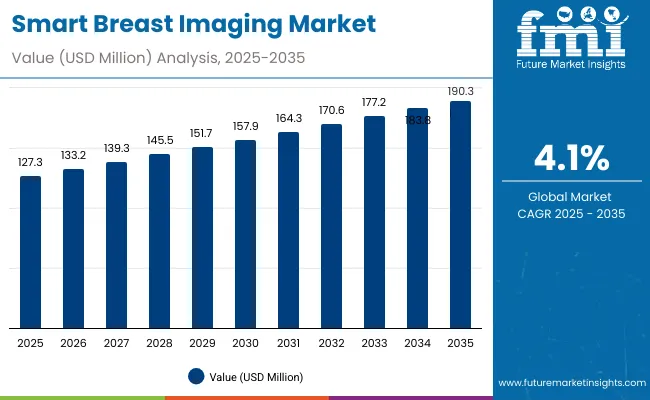
The first half of the decade (2025-2030) will witness the market climbing from USD 127.3 million to approximately USD 155.6 million, adding USD 28.3 million in value, which constitutes 45% of the total forecast growth period. This phase will be characterized by the rapid adoption of breast imaging systems, driven by increasing cancer screening awareness and early detection concerns worldwide. Advanced AI integration capabilities and precision diagnostic features will become standard expectations rather than premium options.
The latter half (2030-2035) will witness sustained growth from USD 155.6 million to USD 190.3 million, representing an addition of USD 34.6 million or 55% of the decade's expansion. This period will be defined by mass market penetration of software & services solutions, integration with comprehensive healthcare management platforms, and seamless compatibility with existing medical infrastructure. The market trajectory signals fundamental shifts in how hospitals and diagnostic centers approach breast cancer screening, with participants positioned to benefit from sustained demand across multiple end-user segments.
The Smart Breast Imaging market demonstrates distinct growth phases with varying market characteristics and competitive dynamics. Between 2025 and 2030, the market progresses through its technology adoption phase, expanding from USD 127.3 million to USD 155.6 million with steady annual increments averaging 4.1% growth. This period showcases the transition from basic imaging units to advanced systems with enhanced AI-powered diagnostic capabilities and integrated screening management systems becoming mainstream features.
The 2025-2030 phase adds USD 28.3 million to market value, representing 45% of total decade expansion. Market maturation factors include standardization of imaging protocols, declining component costs for AI processing arrays, and increasing healthcare awareness of early detection benefits reaching 85-90% effectiveness in cancer screening applications. Competitive landscape evolution during this period features established manufacturers like GE Healthcare expanding their smart breast imaging portfolios while new entrants focus on specialized AI algorithms and enhanced diagnostic accuracy.
From 2030 to 2035, market dynamics shift toward advanced integration and multi-facility deployment, with growth accelerating from USD 155.6 million to USD 190.3 million, adding USD 34.6 million or 55% of total expansion. This phase transition logic centers on software & services systems, integration with healthcare automation networks, and deployment across diverse medical scenarios, becoming standard rather than specialized applications. The competitive environment matures with focus shifting from basic imaging capability to comprehensive diagnostic management systems and integration with hospital information platforms.
The market demonstrates strong fundamentals with breast imaging systems capturing a dominant share through advanced diagnostic capabilities and AI-powered screening deployment capabilities. Hospital applications drive primary demand, supported by increasing healthcare facility spending on early detection systems and cancer screening management solutions. Geographic expansion remains concentrated in developed markets with established healthcare infrastructure, while emerging economies show accelerating adoption rates driven by healthcare modernization and rising cancer awareness.
The smart breast imaging market represents a compelling intersection of healthcare technology, early detection, and AI-powered diagnostics. With robust growth projected from USD 127.3 million in 2025 to USD 190.3 million by 2035 at a 4.1% CAGR, this market is driven by increasing cancer awareness, healthcare infrastructure upgrades, and regulatory pressures for advanced screening practices.
The market's expansion reflects a fundamental shift in how hospitals and diagnostic centers approach breast cancer screening infrastructure. Strong growth opportunities exist across diverse applications, from hospital operations requiring reliable diagnostic accuracy to specialized clinics demanding advanced imaging standards. Geographic expansion is particularly pronounced in Asia-Pacific markets, led by India (4.1% CAGR) and China (3.7% CAGR), while established markets in North America and Europe drive premium positioning and technology innovation.
The dominance of breast imaging systems and hospital applications underscores the importance of proven diagnostic technology and operational reliability in driving adoption. Implementation complexity and healthcare integration requirements remain key challenges, creating opportunities for companies that can simplify deployment while maintaining accuracy standards.
Market expansion rests on three fundamental shifts driving adoption across healthcare and diagnostic sectors. Early detection demand creates compelling clinical advantages through smart breast imaging systems that provide immediate diagnostic insights without compromising accuracy, enabling healthcare facilities to promote preventive care while maintaining patient convenience and reducing diagnostic costs.
Healthcare modernization programs accelerate as hospital operators worldwide seek advanced imaging systems that complement traditional diagnostic processes, enabling precise screening solutions that align with cancer prevention goals and patient safety requirements. Medical infrastructure enhancement drives adoption from hospitals and diagnostic centers requiring effective screening solutions that minimize false positives while maintaining diagnostic accuracy during high-volume screening operations.
However, growth faces headwinds from implementation complexity challenges that vary across healthcare facility types regarding system integration and workflow requirements, potentially limiting deployment flexibility in certain clinical environments. Technical limitations also persist regarding imaging resolution and processing speed that may increase operational costs in high-volume applications with demanding accuracy standards.
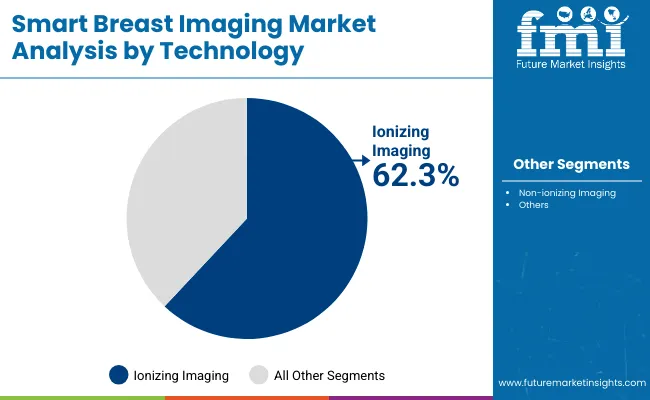
Primary Classification: The market segments by product type into Breast Imaging Systems, Imaging Accessories, and Software & Services categories, representing the evolution from basic imaging systems to comprehensive AI-powered diagnostic solutions for integrated healthcare management.
Secondary Breakdown: Technology segmentation divides the market into Ionizing Imaging and Non-ionizing Imaging sectors, reflecting distinct requirements for diagnostic accuracy, patient safety, and regulatory compliance.
Tertiary Classification: End-user distribution covers Hospitals, Specialty Clinics, Diagnostic Imaging Centers, Breast Care Centers, and Ambulatory Surgical Centers, with hospital applications leading adoption while specialized centers show accelerating growth patterns driven by focused screening programs.
The segmentation structure reveals technology progression from basic breast imaging systems toward integrated AI-powered platforms with enhanced diagnostic capabilities and automated analysis features, while application diversity spans from hospital screening to specialized breast care requiring precise diagnostic management solutions.
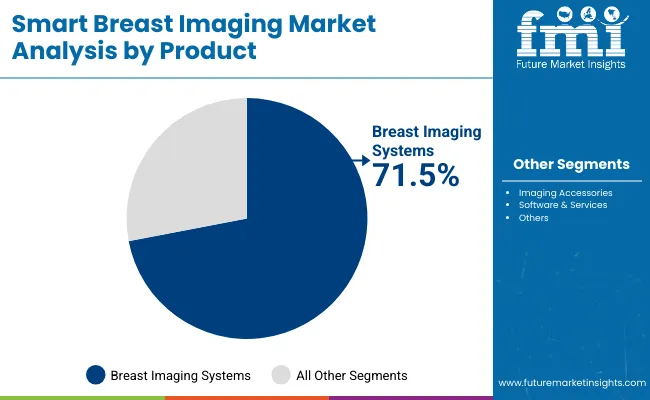
Market Position: Breast Imaging Systems command the leading position in the Smart Breast Imaging market through advanced diagnostic features, including comprehensive cancer detection, high-resolution imaging, and cost-effective screening that enable healthcare facilities to deploy reliable diagnostic solutions across diverse clinical environments.
Value Drivers: The segment benefits from healthcare preference for proven imaging technology that provides immediate diagnostic accuracy without requiring complex workflow modifications. Cost-effective design features enable deployment in hospital environments, diagnostic centers, and specialty clinic applications where reliability and diagnostic precision represent critical operational requirements.
Competitive Advantages: Breast imaging systems differentiate through rapid screening capability, proven diagnostic performance, and integration with standard healthcare systems that enhance facility productivity while maintaining cost-effective operational profiles suitable for diverse medical applications.
Key market characteristics
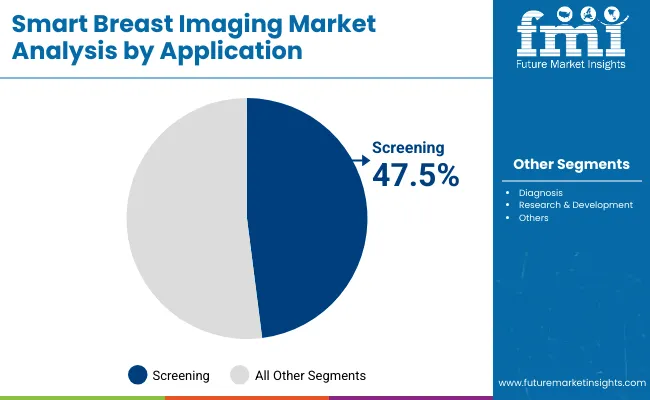
Market Context: Hospital applications dominate the Smart Breast Imaging market due to widespread adoption of advanced diagnostic systems and increasing focus on cancer screening management, patient care quality, and early detection applications that minimize treatment delays while maintaining operational efficiency.
Appeal Factors: Hospital customers prioritize system reliability, diagnostic consistency, and integration with existing healthcare infrastructure that enables coordinated deployment across multiple clinical departments. The segment benefits from substantial capital equipment budgets and modernization programs that emphasize patient care quality for oncology and women's health operations.
Growth Drivers: Healthcare modernization programs incorporate smart breast imaging systems as standard equipment for cancer screening and early detection applications. At the same time, hospital initiatives are increasing demand for AI-powered diagnostics that comply with medical standards and minimize diagnostic errors.
Market Challenges: Implementation requirements and healthcare system compatibility issues may limit deployment flexibility in certain facility types or existing infrastructure scenarios.
Application dynamics include
Growth Accelerators: Healthcare modernization drives primary adoption as smart breast imaging systems provide early detection capabilities that enable cancer screening without compromising accuracy, supporting patient care quality and operational efficiency that require precise diagnostic management. Medical infrastructure demand accelerates market expansion as hospital operators seek effective screening solutions that minimize diagnostic delays while maintaining accuracy during high-volume screening scenarios and patient management operations. Cancer awareness spending increases worldwide, creating sustained demand for AI-powered systems that complement traditional imaging processes and provide operational flexibility in complex healthcare environments.
Growth Inhibitors: Implementation complexity challenges vary across healthcare facility types regarding system integration and workflow requirements, which may limit deployment flexibility and market penetration in facilities with restrictive infrastructure modifications. Technical performance limitations persist regarding processing speed and image quality that may increase operational costs in high-volume applications with demanding accuracy standards and frequent screening patterns. Market fragmentation across multiple regulatory standards and healthcare protocols creates compatibility concerns between different system manufacturers and existing medical infrastructure.
Market Evolution Patterns: Adoption accelerates in hospital and diagnostic center sectors where advanced screening justifies system costs, with geographic concentration in developed markets transitioning toward mainstream adoption in emerging economies driven by healthcare modernization and medical infrastructure development. Technology development focuses on enhanced AI capabilities, improved diagnostic accuracy, and integration with healthcare management systems that optimize screening scheduling and patient care monitoring. The market could face disruption if alternative diagnostic technologies or regulatory restrictions significantly limit smart breast imaging deployment in hospital or clinic applications.
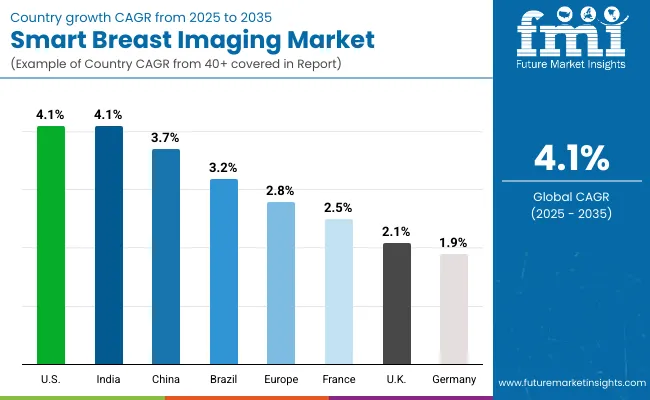
| Country | CAGR (2025 to 2035) |
|---|---|
| India | 4.1% |
| USA | 4.1% |
| China | 3.7% |
| Brazil | 3.2% |
| France | 2.5% |
| UK | 2.1% |
| Germany | 1.9% |
The Smart Breast Imaging market demonstrates varied regional dynamics with Growth Leaders including India (4.1% CAGR) and USA (4.1% CAGR) driving expansion through healthcare modernization and advanced diagnostic infrastructure development. Steady Performers encompass China (3.7% CAGR), Brazil (3.2% CAGR), and Europe (2.8% CAGR), benefiting from established healthcare sectors and medical technology adoption. Moderate Growth Markets feature France (2.5% CAGR), UK (2.1% CAGR), and Germany (1.9% CAGR), where specialized medical applications and healthcare technology integration support consistent growth patterns.
Regional synthesis reveals Asia-Pacific markets leading growth through healthcare modernization and medical infrastructure development, while European countries maintain steady expansion supported by healthcare technology advancement and facility modernization requirements. North American markets show strong growth driven by cancer screening applications and hospital integration trends.
India establishes market leadership through aggressive healthcare modernization programs and comprehensive medical infrastructure development, integrating advanced smart breast imaging systems as standard components in hospital and diagnostic center applications. The country's 4.1% CAGR through 2035 reflects government initiatives promoting healthcare technology and domestic medical capabilities that mandate the use of advanced screening systems in hospital and specialty clinic installations. Growth concentrates in major healthcare centers, including Delhi, Mumbai, and Bangalore, where facility modernization showcases integrated imaging systems that appeal to domestic operators seeking advanced diagnostic solutions and patient care applications.
Indian healthcare providers are developing cost-effective smart breast imaging solutions that combine domestic production advantages with advanced features, including AI-powered diagnostic systems and enhanced screening capacity.
Strategic Market Indicators
In major medical centers, including New York, Los Angeles, and Boston, hospital and diagnostic facilities are implementing advanced smart breast imaging systems as standard equipment for cancer screening operations and early detection applications, driven by increasing healthcare spending and modernization programs that emphasize AI-powered diagnostic infrastructure capabilities.
The market is projected to demonstrate a 4.1% CAGR through 2035, supported by federal healthcare initiatives and medical infrastructure development programs that promote advanced screening systems for hospital and specialty clinic facilities. American healthcare operators are adopting smart breast imaging systems that provide reliable diagnostic accuracy management and cancer screening features, particularly appealing in medical developments where patient care quality represents critical operational requirements.
Market expansion benefits from growing medical technology capabilities and innovation partnerships that enable domestic development of advanced diagnostic systems for hospital and specialty care applications.
Market Intelligence Brief
China's advanced medical technology market demonstrates sophisticated smart breast imaging deployment with documented clinical effectiveness in hospital facilities and diagnostic center applications through integration with existing healthcare management systems and medical infrastructure. The country leverages healthcare expertise in medical imaging and diagnostic systems integration to maintain a 3.7% CAGR through 2035. Major healthcare centers, including Beijing, Shanghai, and Guangzhou, showcase premium installations where smart breast imaging systems integrate with comprehensive hospital platforms and patient management systems to optimize diagnostic accuracy and screening effectiveness.
Chinese healthcare contractors prioritize system reliability and regulatory compliance in smart breast imaging development, creating demand for advanced systems with enhanced features, including AI-powered diagnostic durability and integration with hospital automation systems. The market benefits from established healthcare infrastructure and willingness to invest in advanced medical technologies that provide long-term clinical benefits and compliance with healthcare regulations.
Market Intelligence Brief
Brazil's market expansion benefits from diverse healthcare demand, including facility modernization in São Paulo and Rio de Janeiro, medical equipment upgrades, and government healthcare programs that increasingly incorporate advanced screening solutions for hospital applications. The country maintains a 3.2% CAGR through 2035, driven by rising cancer awareness and increasing recognition of smart breast imaging technology benefits, including reliable diagnostic accuracy and improved patient care capabilities.
Market dynamics focus on cost-effective smart breast imaging solutions that balance advanced AI features with affordability considerations important to Brazilian healthcare operators. Growing medical development creates sustained demand for modern screening systems in new healthcare infrastructure and diagnostic equipment modernization projects.
Strategic Market Considerations
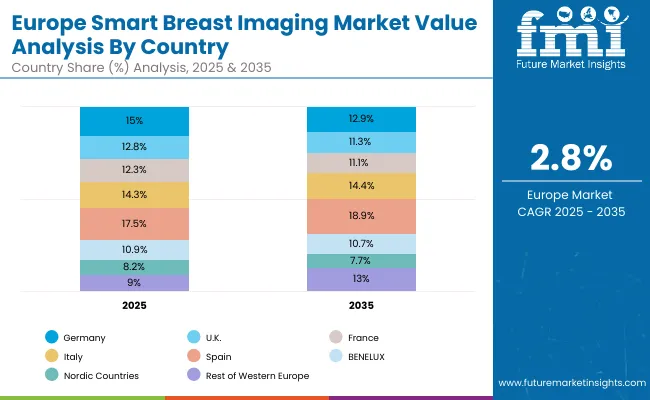
The Smart Breast Imaging market in Europe is projected to grow from USD 35.6 million in 2025 to USD 47.1 million by 2035, registering a CAGR of 2.8% over the forecast period. Spain is expected to maintain momentum with an 18.9% market share by 2035, supported by its advanced healthcare infrastructure and major medical centers, including Madrid and Barcelona.
Italy follows with a 14.4% share by 2035, driven by comprehensive healthcare modernization programs and diagnostic technology development initiatives. Germany holds a 12.9% share by 2035, expected to maintain steady growth through specialized medical applications and regulatory compliance requirements. France commands an 11.1% share, while UK accounts for 11.3% by 2035. The Rest of Western Europe region is anticipated to gain momentum, expanding its collective share to 13.0% by 2035, attributed to increasing smart breast imaging adoption in Nordic countries and emerging Eastern European healthcare facilities implementing medical modernization programs.
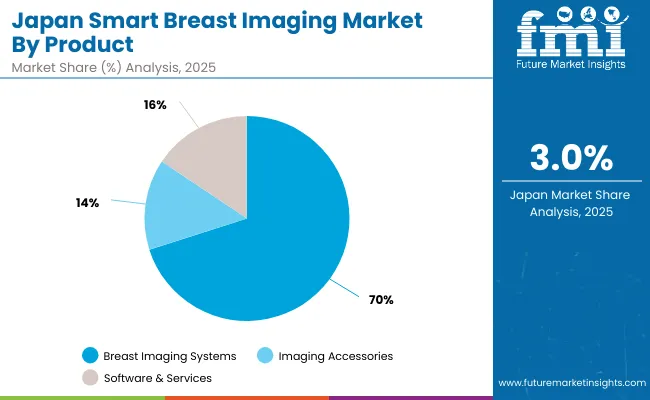
The smart breast imaging market in Japan is set to remain diversified across several product categories in 2025, reflecting clinical preferences and established imaging protocols. Breast Imaging Systems dominate with a 70.1% share in 2025, supported by their central role in comprehensive breast health programs, routine screening procedures, and diagnostic imaging protocols.
Software & Services represent 15.6% in 2025, gaining traction from increasing adoption of digital imaging platforms, artificial intelligence integration, and comprehensive patient management systems. Imaging Accessories hold 14.3%, sustained by their essential role in imaging workflow optimization, image quality enhancement, and equipment functionality support.
The market distribution reflects Japan's mature healthcare system, established imaging infrastructure, and focus on comprehensive quality assurance and patient safety protocols across all breast imaging applications.
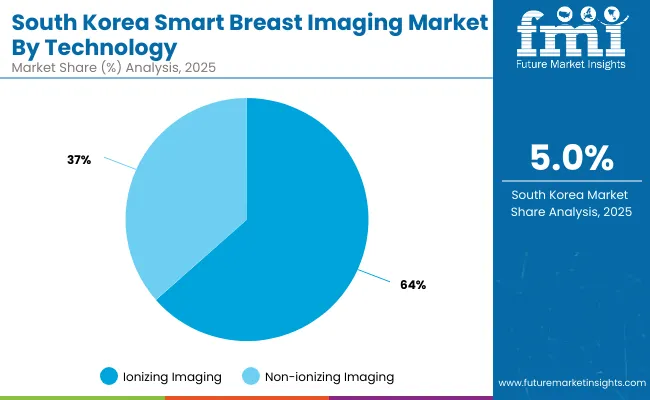
The smart breast imaging market in South Korea in 2025 is characterized by technology preferences reflecting clinical practice patterns and healthcare system priorities. Ionizing Imaging accounts for 63.5%, supported by established clinical protocols, proven diagnostic accuracy, and widespread acceptance among healthcare providers for both screening and diagnostic applications.
Non-ionizing Imaging contributes 36.5%, driven by growing adoption of ultrasound technologies, MRI applications, and emerging imaging modalities that complement traditional mammography protocols. This segment reflects increasing emphasis on comprehensive imaging approaches and multi-modal diagnostic strategies.
The technology distribution highlights South Korea's advanced healthcare infrastructure, commitment to evidence-based imaging protocols, and balanced approach to utilizing both traditional and emerging imaging technologies for optimal patient care and diagnostic accuracy.
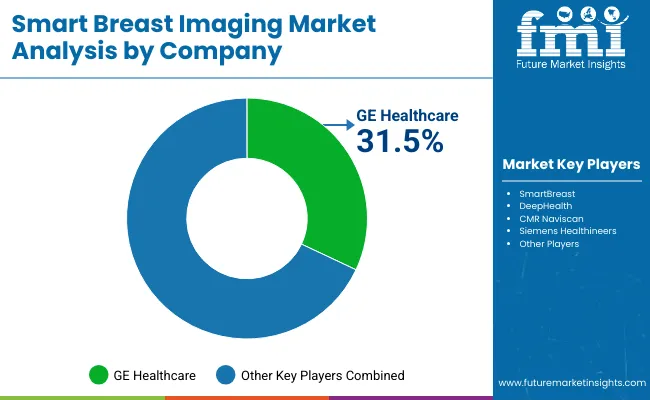
The Smart Breast Imaging market operates with moderate concentration, featuring approximately 15-20 meaningful participants, where leading companies control roughly 45-50% of the global market share through established healthcare facility relationships and comprehensive technology portfolios. Competition emphasizes advanced AI capabilities, diagnostic accuracy, and healthcare integration rather than price-based rivalry.
Market Leaders encompass GE Healthcare, which maintains competitive advantages through extensive medical imaging expertise, global healthcare equipment networks, and comprehensive system integration capabilities that create customer switching costs and support premium pricing. The company leverages decades of medical technology experience and ongoing research investments to develop advanced smart breast imaging systems with enhanced AI and healthcare management features.
Technology Challengers include SmartBreast, DeepHealth, CMR Naviscan, and Siemens Healthineers, which compete through specialized AI technology focus and innovative diagnostic interfaces that appeal to healthcare customers seeking advanced screening capabilities and operational flexibility. These companies differentiate through rapid technology development cycles and specialized medical application focus.
Market dynamics favor participants that combine reliable imaging hardware with advanced AI software, including diagnostic accuracy tracking and automatic screening alert capabilities. Competitive pressure intensifies as traditional medical equipment manufacturers expand into AI-powered diagnostic systems. At the same time, software companies challenge established players through innovative AI solutions and cost-effective platforms targeting specialized healthcare segments.
| Item | Value |
|---|---|
| Quantitative Units | USD 127.3 Million |
| Product Type | Breast Imaging Systems, Imaging Accessories, Software & Services |
| Technology | Ionizing Imaging, Non-ionizing Imaging |
| Application | Screening, Diagnosis, Research & Development |
| End User | Hospitals, Specialty Clinics, Diagnostic Imaging Centers, Breast Care Centers, Ambulatory Surgical Centers |
| Regions Covered | North America, Europe, Asia Pacific, Latin America, Middle East & Africa |
| Countries Covered | China, India, Germany, Brazil, the USA, the UK, France, and 25+ additional countries |
| Key Companies Profiled | GE Healthcare, SmartBreast, DeepHealth, CMR Naviscan, Siemens Healthineers |
| Additional Attributes | Dollar sales by product type and application categories, regional adoption trends across North America, Europe, and Asia-Pacific, competitive landscape with medical equipment manufacturers and technology providers, healthcare facility preferences for diagnostic accuracy and system reliability, integration with healthcare management platforms and patient information systems, innovations in AI technology and screening efficiency, and development of software & services solutions with enhanced diagnostic capabilities and automated analysis features. |
The global Smart Breast Imaging market is valued at USD 127.3 million in 2025.
The size of the Smart Breast Imaging market is projected to reach USD 190.3 million by 2035.
The Smart Breast Imaging market is expected to grow at a 4.1% CAGR between 2025 and 2035.
The key product type segments in the Smart Breast Imaging market are Breast Imaging Systems, Imaging Accessories, and Software & Services.
In terms of product type, the Breast Imaging Systems segment is set to command the dominant share in the Smart Breast Imaging market in 2025.






Our Research Products

The "Full Research Suite" delivers actionable market intel, deep dives on markets or technologies, so clients act faster, cut risk, and unlock growth.

The Leaderboard benchmarks and ranks top vendors, classifying them as Established Leaders, Leading Challengers, or Disruptors & Challengers.

Locates where complements amplify value and substitutes erode it, forecasting net impact by horizon

We deliver granular, decision-grade intel: market sizing, 5-year forecasts, pricing, adoption, usage, revenue, and operational KPIs—plus competitor tracking, regulation, and value chains—across 60 countries broadly.

Spot the shifts before they hit your P&L. We track inflection points, adoption curves, pricing moves, and ecosystem plays to show where demand is heading, why it is changing, and what to do next across high-growth markets and disruptive tech

Real-time reads of user behavior. We track shifting priorities, perceptions of today’s and next-gen services, and provider experience, then pace how fast tech moves from trial to adoption, blending buyer, consumer, and channel inputs with social signals (#WhySwitch, #UX).

Partner with our analyst team to build a custom report designed around your business priorities. From analysing market trends to assessing competitors or crafting bespoke datasets, we tailor insights to your needs.
Supplier Intelligence
Discovery & Profiling
Capacity & Footprint
Performance & Risk
Compliance & Governance
Commercial Readiness
Who Supplies Whom
Scorecards & Shortlists
Playbooks & Docs
Category Intelligence
Definition & Scope
Demand & Use Cases
Cost Drivers
Market Structure
Supply Chain Map
Trade & Policy
Operating Norms
Deliverables
Buyer Intelligence
Account Basics
Spend & Scope
Procurement Model
Vendor Requirements
Terms & Policies
Entry Strategy
Pain Points & Triggers
Outputs
Pricing Analysis
Benchmarks
Trends
Should-Cost
Indexation
Landed Cost
Commercial Terms
Deliverables
Brand Analysis
Positioning & Value Prop
Share & Presence
Customer Evidence
Go-to-Market
Digital & Reputation
Compliance & Trust
KPIs & Gaps
Outputs
Full Research Suite comprises of:
Market outlook & trends analysis
Interviews & case studies
Strategic recommendations
Vendor profiles & capabilities analysis
5-year forecasts
8 regions and 60+ country-level data splits
Market segment data splits
12 months of continuous data updates
DELIVERED AS:
PDF EXCEL ONLINE
Smart School Bus Platform Market Size and Share Forecast Outlook 2025 to 2035
Smart Home Wireless Smoke Detector Market Size and Share Forecast Outlook 2025 to 2035
Smart Bus Platform Market Size and Share Forecast Outlook 2025 to 2035
Smart Vision Processing Chips Market Size and Share Forecast Outlook 2025 to 2035
Smart Touch Screen Scale Market Size and Share Forecast Outlook 2025 to 2035
Smart Magnetic Drive Conveyor System Market Size and Share Forecast Outlook 2025 to 2035
Smart Wheelchair market Size and Share Forecast Outlook 2025 to 2035
Smart Mining Technologies Market Size and Share Forecast Outlook 2025 to 2035
Smart Parking Market Size and Share Forecast Outlook 2025 to 2035
Smart Digital Valve Positioner Market Forecast and Outlook 2025 to 2035
Smart Card IC Market Size and Share Forecast Outlook 2025 to 2035
Smart-Tag Inlay Inserters Market Analysis - Size and Share Forecast Outlook 2025 to 2035
Smart TV Market Forecast and Outlook 2025 to 2035
Smart/AI Toy Market Size and Share Forecast Outlook 2025 to 2035
Smart Locks Market Size and Share Forecast Outlook 2025 to 2035
Smart Sprinkler Controller Market Size and Share Forecast Outlook 2025 to 2035
Smart Indoor Gardening System Market Size and Share Forecast Outlook 2025 to 2035
Smart Building Delivery Robot Market Size and Share Forecast Outlook 2025 to 2035
Smart Watch Market Size and Share Forecast Outlook 2025 to 2035
Smart Label Market Size and Share Forecast Outlook 2025 to 2035

Thank you!
You will receive an email from our Business Development Manager. Please be sure to check your SPAM/JUNK folder too.
Chat With
MaRIA